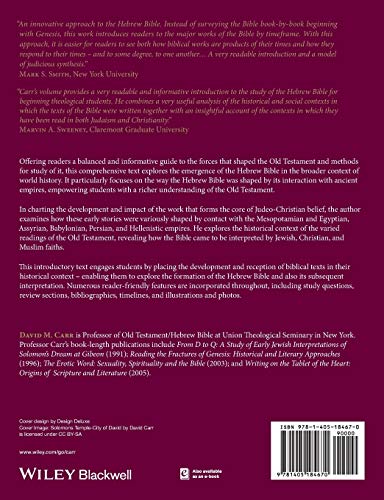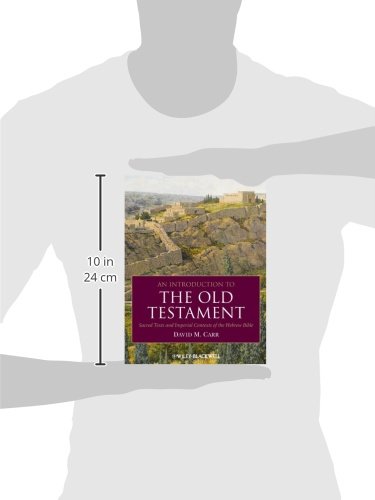Customer Services
Copyright © 2025 Desertcart Holdings Limited
Desert Online General Trading LLC
Dubai, United Arab Emirates




An Introduction to the Old Testament: Sacred Texts and Imperial Contexts of the Hebrew Bible
B**D
A nice, glossy, expensive book, lots of pictures.
An introduction to the Old Testament. Sacred Texts and Imperial Contexts of the Hebrew Bible. by David M. CarrFor the sake of full disclosure, I must say I had this book as a text for a graduate level introduction to the OT, and for that, I believe it was not appropriate. There was simply not enough graduate level bang for the buck, especially since it was used in tandem with a book which did an excellent job of outlining the historical and social contexts of the OT writings. As a text, it may have been perfect as the only text, in addition to an annotatied Bible, for an undergraduate 1 semester course in the OT. At the graduate level, the role of this book should have been taken by a good history of Israel such as John Bright's 'A History of Israel'.My opinion is colored a fair amount by the price, compared to the prices of other books in the field (However a strong competitor in this field, 'The Old Testament' 2nd Edition by Harris and Platzner is even more expensive, although it is also twice as long, with fewer glossy pictures). It seems that when a class uses three different texts, there should be less overlap in content.Carr's book reminds me of a large number of 'introductory' or 'survey' or 'popular topic' cookbooks with lots of pictures, sidebars, boxes, and diversions. To my taste, they do more to divert one's attention than to aid in absorbing the information. If Julia Child had intended there to be glossy pictures in cookbooks, she would have put them in 'Mastering the Art of French Cooking'. (Just being a tad glib there.) There are some artifacts and scenes and especially maps which are indispensible. I like the pics of the Hammurabi stela and the Sennacherib prism, but I didn't need another look at Adam and Eve or Babylonian arrowheads in the dust. Note that the index seemed a bit light. The sidebar on the Sennacherib prism takes op an entire page, but 'Sennacherib' is not in the index.The other side of the coin is that the study aids, especially the bibliographical, is very good. The book gives only one reference for Daniel, but that reference may be the best one available. I thought the references on Job were a bit light, and it seemed odd that Job, at 42 chapters, got no more than three times the attention as Jonah, at 4 chapters.This is a good OT textbook, it is not a 'great' one. For comparable visual material and superior bibliography, I would recommend Harris and Platzner for personal reading, even though it is more expensive.
D**H
Nice
Nice. Almost new.
S**T
Four Stars
Good resource focusing on historical-critical issues in the Old Testament.
T**E
Pretty good for a textbook
I bought this for a class I was taking about the Hebrew Bible and I found it to be very interesting and informative. It definitely helped me to better understand the subject so I would highly recommend it as a textbook.
M**S
OT
Very nice book. The book got home in the right time. The reading is good. I recommend it. I hope I can read it this month.
J**O
incredibly knowledge-packed
A great text by a careful and insightful scholar. Glad it's one of my text books for seminary this fall.
P**U
Five Stars
I have found the text very easy to read and understand. Thanks much
D**H
Hypothetical Introduction to the Old Testament
David Carr's Introduction to the Old Testament (in title only, elsewhere the "Hebrew Bible" is used) is let down by its highly hypothetical (I would like to add politically correct, but will let that pass) approach to reconstructing the text of the Old Testament.Carr's reliance (and confidence) in breaking up the Old Testament into layers is nothing new. Ironically, while at the same time he notes that the J/E source theory is no longer popular he goes on to confidently assert specific redaction and stratification of texts (which, to be fair, he notes as "hypothetical" but then proceeds to base much of his work on). Thus the Pentateuch is asserted to be a composite of L (Lay) and P (Priestly) sources. I suspect even Carr knows this won't hold water for long.Source-theory-of-the-month aside, my main issue here is that Carr rarely if ever stops to consider what the Old Testament/Hebrew Bible tries to say and instead goes on and on about why this author wrote in this way, dragging in feminist and post-colonial criticism (sigh) and so on. Nice conjectures, but the world of Biblical scholarship moves on and don't be surprised to find this become another curiously outdated fossil in Biblical literature.To be frank my more conservative prejudices show here, but I don't really care who you think wrote the Old Testament/Hebrew Bible, but at least please talk a little about what it says.Perhaps it was my digital edition, but there are no footnotes or bibliography only "Resources for further study". I unfortunately was not able to check up on the author's assertions whenever I wanted to, which aggravated me further.
G**D
Brilliant book
This is a fab book if you are studying the Pentateuch.
J**K
Five Stars
excellent content for self- study / recommend
A**R
Five Stars
i enjoy this book and it will help me with my personal develop and research
Trustpilot
5 days ago
1 month ago